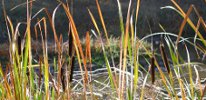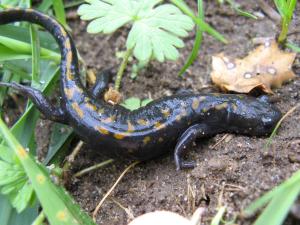
Training
Santa Cruz Long-Toed Salamander Workshop 2014

Topics discussed included: the geographic distribution of Santa Cruz long-toed salamanders and related species, upland and aquatic habitats and their management, movements, population and community ecology, survey methods, and methods for assessing potential project impacts and approaches for avoidance and minimization.
COST: $255.00
Payable by check to Elkhorn Slough Foundation
Payable by credit card (online)
REGISTRATION FOR THIS PROGRAM IS CLOSED
Instructor Information
Dr. Wesley Savage
Department of Biological Sciences, University of Massachusetts
Contact
Virginia Guhin
virginia@elkhornslough.org
(831) 274-8700
Sponsors
Description
See also: Santa Cruz Long-Toed Salamander, Habitat Restoration
The Elkhorn Slough Coastal Training Program hosted the Santa Cruz long-toed salamander workshop and field session on June 5, 2014 at the Elkhorn Slough National Estuarine Research Reserve.
Intended Audience: biological consultants, land managers, researchers, and regulatory agency personnel.
Workshop Objectives:
- Attendees will understand the basic biology and ecology of the highly endangered Santa Cruz long-toed salamander
- Attendees will understand how this information can be applied to habitat management for this species
Topics Discussed:
The geographic distribution of Santa Cruz long-toed salamanders and related species, upland and aquatic habitats and their management, movements, population and community ecology, survey methods, and methods for assessing potential project impacts and approaches for avoidance and minimization. The information conveyed will be useful in large-scale and local conservation planning efforts.
Workshop Details:
Workshop registration included a classroom lecture and field session on June 5.
Workshop Format:
Thursday, June 5 Classroom Session (8:30am-3:00pm) - Wesley Savage presented a comprehensive lecture on the biology and conservation of the Santa Cruz long-toed salamander (Ambystoma macrodactylum croeceum, a.k.a. “SCLTS”).
Thursday, June 5 Afternoon Session (4:00pm – 7:30pm) - Field work focused on habitat assessment and survey techniques at a location known to support the species. Movement patterns, identification protocol, and habitat management techniques will also be discussed. Personal vehicles required to travel to field site and liability waiver required. There was not an opportunity for capture or species handling due to the unavailability of ponds with suitable water levels to support the species this year.
Documents and Publications
Contact List
We encourage participants to download the contact list to assist with arranging a rideshare or to get in contact with someone you met at the
workshop. Those interested in sharing a ride to the event are marked on the contact list.
| DOCUMENT | AUTHOR / SOURCE |
|---|---|
| WORKSHOP MATERIALS | |
| Read Me SCLTS 2014 DOC, 25KB |
Virginia Guhin 2014 |
| SCLTS Workshop Bibliography DOCX, 27KB |
Wesley Savage 2014 |
| SCLTS Workshop Presentation PDF, 17.4MB |
Wesley Savage Elkhorn Slough Coastal Training Program 2014 |
| PEER-REVIEWED PUBLICATIONS | |
| A Comparison of the Life Histories of Coastal and Montane Populations of Ambystoma macrodacytlon in California PDF, 3.1MB |
James D. Anderson The American Midland Naturalist 77(2):323-355 1967 |
| Recovery Plan (Draft): Santa Cruz long-toed salamander PDF, 23.6MB |
US Fish and Wildlife Service USFWS 2004 |
| Species account: Santa Cruz long-toed salamander DOC, 9MB |
American Society of Ichthyology and Herpetology 1963 |
| OTHER INFORMATION | |
| Santa Cruz County Planning Department Policy: Site Disturbance and Impervious Surface in the Salamander Protection Zone PDF, 57KB |
Santa Cruz County Planning Department County of Santa Cruz 1/1/03 |
| Tissue Collection Protocol for Genetic Research PDF, 270KB |
K.E. Leyse, A.J. Lind, W.K. Savage, H.B. Shaffer, and M.R. Stephens Elkhorn Slough Coastal Training Program April 2009 |
Questions and Answers
Submit a question on this subject and we'll provide an answer. coastaltraining@elkhornsloughctp.org
